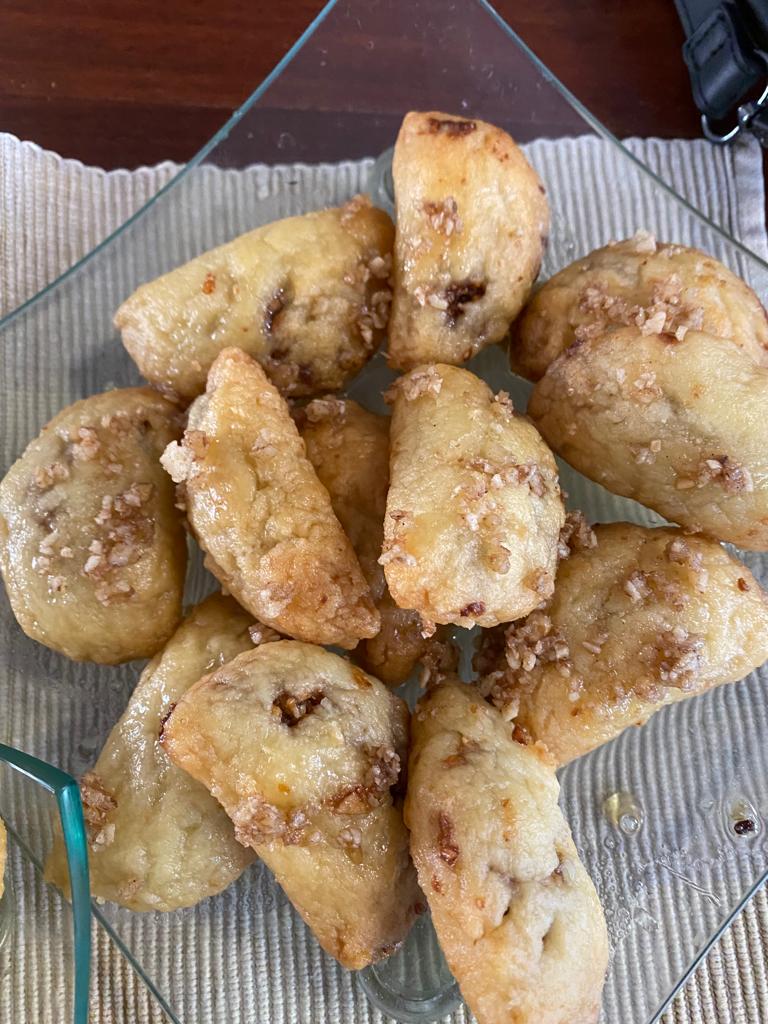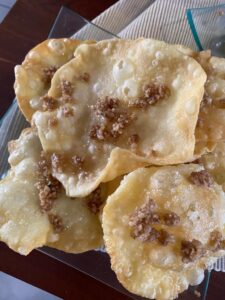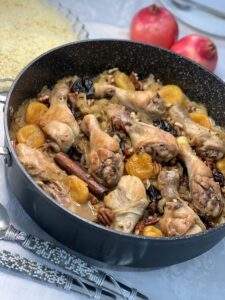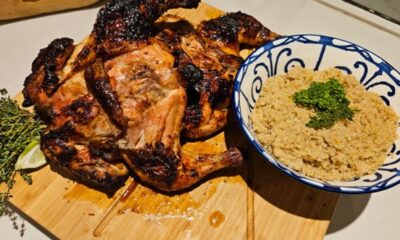
Lifestyle

Enjoy the new year the Sephardi way
Sephardi Jews celebrate Rosh Hashanah with delicious delicacies, so different from traditional Ashkenazi fare. The SA Jewish Report asked Rifca Sommer in Zimbabwe, and Esti Cohen and Liat Amar Arran in Israel to share a few Rosh Hashanah recipes with us.
Rifca Sommer is a caterer and cooking teacher who runs Rifca’s Kitchen in Bulawayo, Zimbabwe. She is a proud Sephardic Jew, with both her parents hailing from the small Mediterranean island of Rhodes.
Pitikas
Thinly rolled out dough, fried and sprinkled with nuts, honey, or syrup

Ingredients
½ cup oil
1 cup water
3½ cups flour
Pinch bicarbonate of soda
Honey
Cinnamon
Ground almonds
Method
Mix oil and water.
Add bicarbonate of soda.
Add as much flour as required to make soft dough (all the flour may not be required).
Form into round balls the size of a R1 coin.
Leave the balls to rest for half an hour covered with some cling film.
Rub a little oil onto the table surface, and roll each ball very thinly to the size of a saucer.
Deep fry in hot oil until dough puffs up and is golden.
Drain on paper towel.
Sprinkle each pastry with ground almonds, cinnamon, and honey.
Travados
Dough turnovers with nut filling

Ingredients for dough
1 cup oil
⅓ cup water
⅓ cup sugar
2½ cups flour
Method
Use one cup flour at a time.
Mix all the ingredients together.
The dough must be soft but malleable.
Make into small balls the size of a R2 coin, and leave to rest covered with a piece of cling film.
Ingredients for filling
75g ground almonds
75g round walnuts
3 tablespoons honey
2 tablespoons water
½ teaspoon mixed spice
1 level teaspoon of cinnamon
Method
Mix all ingredients together so that it’s wet enough to make a small ball.
Ingredients for syrup
½ cup sugar
½ cup honey
½ cup water
Method
Bring to the boil, which should take about three minutes.
Combining the dough, filling, and syrup
Flatten a ball of dough in the palm of your hand.
Put about a small teaspoon of filling in the middle and fold the dough over and press together.
The dough may crack a bit and that’s fine so long as the filling is in the dough.
Bake at 180 degrees centigrade until golden brown.
Drop baked travados into the syrup in batches, and simmer for two minutes.
Put onto a platter, drizzle with more of syrup, and sprinkle ground nuts over it.
Esti Cohen is the former owner of Esti’s, a boutique bakery, and lives in Israel after seven years in South Africa. Her Moroccan roots are a big part of her cooking, which she’s passionate about.
Moroccan Apricot Chicken Tagine

Ingredients
8-10 chicken legs
3 onions, thinly sliced into half circles
3 tablespoons of oil
100g dried prunes (without pits)
100g dried apricots or peaches
100g yellow raisins
1 small cinnamon bark or ½ teaspoon of cinnamon as a substitute
¼ teaspoon nutmeg
1½ tablespoons of sugar
1 teaspoon salt
½ teaspoon black pepper
2 cups boiling water
50g raw pecans, roughly chopped (optional)
Method
Begin by soaking the prunes, apricots, or peaches, and raisins in warm water for about 15 minutes, and then drain them.
In a wide pot, sear the chicken on all sides until it’s nicely browned. Once browned, transfer it to a separate dish.
In the same pot, add three tablespoons of oil, and fry the sliced onions. Add the one and a half tablespoons of sugar, and stir until the onions turn translucent and start to brown.
Rinse the dried fruit, and add it to the pot, mixing it in with the onions.
Season with ¼ teaspoon of nutmeg, salt, and black pepper.
Add the cinnamon bark (or substitute it with ½ teaspoon of cinnamon).
Place the chicken pieces back into the pot, arranging them on top, and pour in two cups of boiling water. Reduce the heat, and let it simmer for about 45 minutes or until the liquid has reduced to a sauce.
If desired, sprinkle with roughly chopped pecans a minute before turning off the heat.
The dish pairs excellently with couscous.
Liat Amar Arran is the outgoing director of the Israel Centre in South Africa.
My late mother would take the symbolic Rosh Hashanah foods, like pumpkin, green beet, and leeks, and make them into simanim pies.
The pumpkin, which we call kara (to call), on which we prayed, “May our victories be read before G-d, and may the good G-d tear apart the evil of our judgement.”
Beetroot, which we calk selek (remove), on which we prayed, “Our enemies and our haters and all those who seek our harm will be removed/depart.”
And a leek called karti (cut down), on which we prayed, “Our enemies and our haters and all those who seek our harm will be cut down.”
How much hatred and evil we tried to keep away! In current times, we also pray to rid ourselves of the enemies within – our negative thoughts, harmful habits, and troubled minds – in the hope of a good and happy new year.
Pumpkin/green beet and leek pie
Ingredients
Pumpkin – cut into small cubes and lightly fried
Green beets – cut only the green leaves, cut and steam a little to release the liquid
Leek – cut thinly and lightly fried
Fry four to five large cut onions
Method
In a bowl, for every half kilo of vegetables, add two eggs, three tablespoons of flour, fried onion, black pepper, salt, and two tablespoons of oil.
Mix well, and put in two greased cake pans in the oven to make a total of six pies, for both first and second night Rosh Hashanah.
Enjoy, and shana tova!










